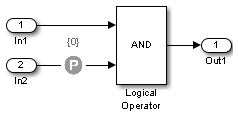Proof Objective
Define objectives that signals must satisfy when proving model properties
Libraries:
Simulink Design Verifier /
Objectives and Constraints
Description
When operating in property-proving mode, the Simulink® Design Verifier™ software proves that properties of your model satisfy specified criteria (see Prove Model Properties Using Simulink Design Verifier). In this mode, you can use Proof Objective blocks to define proof objectives for signals in your model.
The Values parameter lets you specify acceptable values for the block's input signal. If a signal value deviates from the acceptable values in any time step, a property violation occurs and the proof objective is falsified. The block applies the specified Values parameter to its input signal, and the Simulink Design Verifier software proves or disproves that the properties of your model satisfy the specified criteria.
The block's parameter dialog box allows you to
Enable or disable the objective.
Specify that the block should display its Values parameter in the Simulink Editor.
Specify that the block should display its output port.
Note
The Simulink and Simulink Coder™ software ignore the Proof Objective block during model simulation and code generation, respectively. The Simulink Design Verifier software uses the Proof Objective block only when proving model properties.
Specifying Proof Objectives
Use the Values parameter to define values that a signal must achieve during a proof simulation. Specify any combination of scalars and intervals in the form of a MATLAB® cell array. For information about cell arrays, see Cell Arrays.
Tip
If the Values parameter specifies only one scalar value, you do not need to enter it in the form of a MATLAB cell array.
Scalar values each comprise a single cell in the array, for example:
{0, 5}A closed interval comprises a two-element vector as a cell in the array, where each element specifies an interval endpoint:
{[1, 2]}Alternatively, you can specify scalar values using the
Sldv.Point constructor, which accepts a single value as its
argument. You can specify intervals using the Sldv.Interval
constructor, which requires two input arguments, i.e., a lower bound and an upper
bound for the interval. Optionally, you can provide one of the following values as a
third input argument that specifies inclusion or exclusion of the interval
endpoints:
'()'— Defines an open interval.'[]'— Defines a closed interval.'(]'— Defines a left-open interval.'[)'— Defines a right-open interval.
Note
By default, Sldv.Interval considers an interval to be
closed if you omit its third input argument.
As an example, the Values parameter
{0, [1, 3]}specifies:
0— a scalar[1, 3]— a closed interval
The Values parameter
{Sldv.Interval(0, 1, '[)'), Sldv.Point(1)}specifies:
Sldv.Interval(0, 1, '[)')— the right-open interval [0, 1)Sldv.Point(1)— a scalar
If you specify multiple scalars and intervals for a Proof Objective block, the Simulink Design Verifier software combines them using a logical OR operation during the property proof. In this case, the software considers the entire proof objective to be satisfied if any single scalar or interval is satisfied.
Ports
Input
Parameters
Extended Capabilities
Version History
Introduced in R2007a

